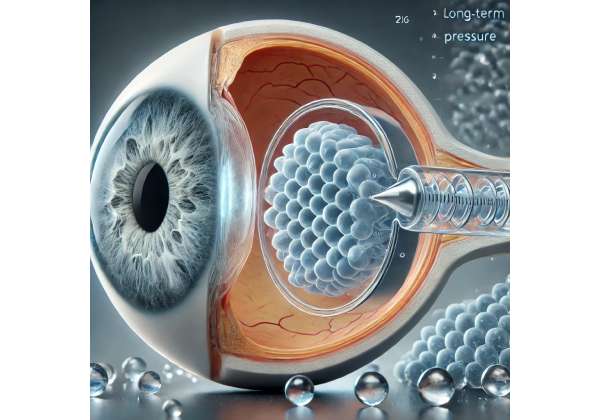InGel Cell Therapy for Retinitis Pigmentosa Cone Preservation Treatment Providing Light Sensitivity Support in Retinal Degeneration
Retinitis Pigmentosa (RP) is a collection of hereditary retinal disorders characterized by the gradual loss of photoreceptor cells, often beginning with rod cells and eventually impacting cone cells responsible for central, high-acuity, and color vision. As the disease progresses, individuals typically experience symptoms like night blindness, peripheral vision loss, and difficulties with contrast sensitivity. Over time, these symptoms can...
Infrared Thermotherapy for Diabetic Macular Edema Enhancing Retinal Health with Heat
Diabetic macular edema (DME) represents a major complication of diabetic retinopathy, a leading cause of vision impairment in adults with long-standing diabetes. Excess fluid accumulates in the macula—the central region of the retina responsible for sharp, detailed sight—resulting in blurred vision, difficulty reading, and challenges in recognizing faces. Traditional treatments for DME often include intravitreal injections of anti-VEGF agents...
Infrared Laser Therapy for Retinal Vein Occlusion A Non-Surgical Approach to Reducing Edema
Retinal vein occlusion (RVO) is one of the most frequent vascular disorders affecting the retina, often leading to sudden or progressive vision impairment. The primary issue arises when the veins responsible for draining blood from the retina become blocked, allowing fluid to leak into the macular region. This leakage triggers swelling—commonly referred to as macular edema—which interferes with central...
Infliximab for Refractory Scleritis New Insights in Controlling Eye Inflammation
Scleritis is a severe inflammatory disease that affects the tough outer layer of the eye (the sclera), often leading to pain, redness, and, in advanced cases, permanent vision damage. When standard medications like corticosteroids or traditional immunosuppressants fail to control the condition, it is classified as “refractory” scleritis. For these challenging cases, infliximab—a tumor necrosis factor-alpha (TNF-α) inhibitor—has emerged...
Improving Visual Acuity in Myopic Astigmatism The Role of ReLEx SMILE’s Advanced Technique
Refractive errors like myopic astigmatism can significantly impact everyday life, from performing routine tasks to enjoying leisure activities. When the natural focusing power of the eye struggles with both nearsightedness (myopia) and the corneal irregularities of astigmatism, individuals often experience blurred vision, headaches, or eye fatigue. These symptoms can disrupt work, affect academic performance, and diminish overall quality of...
Improving Dry Eye Symptoms with Devices to Normalize Tear Osmolarity An Innovative Approach
Dry eye disease affects millions of individuals worldwide, leading to discomfort, blurred vision, and a persistent gritty or burning sensation in the eyes. Although numerous factors can contribute to this condition, one of the most critical is an imbalance in tear osmolarity. When the tear film becomes hyperosmolar—too rich in salts relative to water content—it causes irritation, inflammation, and...
Iluvien for Diabetic Macular Edema Long-Term Control with a Modern Fluocinolone Acetonide Implant
Iluvien is a cutting-edge intravitreal implant that releases fluocinolone acetonide over an extended period, providing a novel avenue for long-term control of diabetic macular edema. Since diabetic macular edema often leads to vision impairment, effective therapies that reduce the need for frequent interventions have garnered attention among healthcare professionals and patients alike. By leveraging a slow, sustained release of...
Iluvien (Intravitreal Fluocinolone Acetonide) Long-Acting Corticosteroid for Chronic Diabetic Retinopathy Management
Iluvien, an innovative intravitreal implant delivering fluocinolone acetonide, has gained significant attention in the field of diabetic retinopathy management. As chronic diabetic retinopathy can progress to vision-threatening stages, novel long-acting therapeutic approaches play a pivotal role in reducing treatment burden and improving patient outcomes. Iluvien seeks to address the persistent inflammatory pathways involved in diabetic retinopathy progression by releasing...
ILB® Therapy The Groundbreaking Dextran-Sulfate Approach for Glaucoma
Glaucoma is a leading cause of irreversible vision loss worldwide, primarily characterized by progressive damage to the optic nerve. For decades, treatments have focused on lowering intraocular pressure (IOP) through topical medications, laser therapies, or surgical interventions. Yet, many individuals still struggle to prevent disease progression over the long term, often due to suboptimal response or difficulties adhering to...
iDose TR Implant Revolutionizing Glaucoma Treatment with 3-Year Medication Delivery
Glaucoma poses a significant challenge for millions of individuals worldwide, as it often requires daily medication regimens to control intraocular pressure and prevent irreversible vision loss. Patients and clinicians have long grappled with the need for consistent adherence to eye drops and the associated risk of forgetting doses or experiencing side effects. With these hurdles in mind, the development...
Hyperbaric Oxygen Therapy for Anterior Segment Ischemia Is It the Missing Piece in Eye Surgery Recovery
Anterior segment ischemia presents a profound challenge to patients and eye surgeons alike. Characterized by reduced blood flow to the front portion of the eye, it can emerge after complex or extensive ocular procedures. Once the delicate tissue in the anterior segment is deprived of oxygen, inflammation and damage can set in swiftly, leading to blurred vision, discomfort, and...
Hyperbaric Oxygen Therapy A New Hope for Radiation-Induced Optic Neuropathy Treatment
Radiation-induced optic neuropathy is a rare but serious complication that can occur after radiation therapy to the head and neck area. This condition involves damage to the optic nerve, which may lead to partial or even complete vision loss if left unaddressed. In many cases, the onset is gradual, making it challenging to catch early. Although various interventions have...
Hydrus Microstent Advancing Fluid Drainage and Reducing Cell Damage in Glaucoma
Glaucoma is a multifaceted eye condition marked by elevated intraocular pressure that can damage the optic nerve over time, potentially leading to progressive vision loss. This disease often results from improper drainage of the aqueous humor, a clear fluid that nourishes essential structures within the eye. Early and effective management is crucial, as glaucoma remains one of the leading...
Hydrogel-Based Implants Long-Term Pressure Control for Glaucoma Patients
Glaucoma is one of the world’s leading causes of irreversible blindness, affecting millions of people across different age groups and ethnicities. Characterized by progressive damage to the optic nerve, glaucoma often arises from elevated intraocular pressure (IOP) that compromises blood flow and nerve fiber health. Although the condition initially presents with few to no symptoms, untreated high IOP eventually...
Hydrogel Injections for Corneal Support Recently Approved Injectable Enhancing Structural Integrity in Keratoconus
Keratoconus is a progressive eye disorder that weakens the cornea, causing it to bulge into a cone-like shape. This abnormal curvature distorts vision and often leads to severe astigmatism, light sensitivity, and other vision challenges. For many patients, spectacles or even specialized contact lenses may no longer adequately correct eyesight as the disease advances. Traditional treatments like corneal cross-linking,...
Humira (Adalimumab) for Non-Infectious Uveitis Vision Protection with Anti-TNF Therapy
Non-infectious uveitis is a major cause of visual impairment worldwide, stemming from inflammation within the uveal tract—the pigmented layers of the eye that include the iris, ciliary body, and choroid. Unlike infectious uveitis, which arises from bacteria, viruses, or parasites, non-infectious uveitis typically involves autoimmune or autoinflammatory processes. If left uncontrolled, persistent inflammation can damage vital structures such as...
Human Embryonic Stem Cell-Derived RPE Transplants Transforming Age-Related Macular Degeneration Care
Age-related macular degeneration (AMD) remains one of the most prevalent causes of irreversible vision loss among older adults worldwide. As the macula—the central region of the retina responsible for sharp, detailed vision—begins to deteriorate, patients commonly experience progressive difficulties with tasks like reading, driving, and face recognition. This degenerative condition, especially in its advanced (dry) form, has historically posed...
Human Corneal Tissue Transplants with Cross-Linking Combined Procedure for Long-Term Structural Support in Severe Keratoconus
Keratoconus is a progressive eye disease marked by a thinning and bulging of the cornea, resulting in distorted vision and increased sensitivity to light. As the condition advances, the normally dome-shaped cornea transforms into a cone-like structure, making it difficult to correct with standard eyeglasses. In mild to moderate cases, specialized contact lenses or corneal collagen cross-linking (CXL) alone...
How the PRIMA System Helps Patients with Vision Loss A Revolutionary Retinal Prosthesis
Age-related macular degeneration (AMD) and other advanced retinal disorders are leading causes of progressive, sometimes severe vision loss. Millions of people worldwide grapple with the daily realities of decreasing sight—such as difficulty reading, recognizing faces, or navigating spaces that were once familiar. While modern medicine has produced treatments that slow or stabilize certain forms of retinal disease, individuals with...
How the Implantable Miniature Telescope Improves Vision in Advanced Age-Related Macular Degeneration
Age-related macular degeneration (AMD) remains one of the primary causes of irreversible vision loss among adults over 50, especially in the developed world. As the disease progresses to its late stages, patients typically notice a widening blind spot in their central field of vision, making daily activities such as reading, driving, or even recognizing faces increasingly difficult. While treatments...
How Stem Cell Therapy with Retinal Pigment Epithelium Cells Brings New Hope for Stargardt Disease Patients
Stargardt disease is an inherited retinal disorder that leads to progressive vision loss, most notably affecting the macula, the central region of the retina responsible for sharp, detailed sight. Patients commonly experience a gradual decline in their ability to see fine detail and color, significantly impacting daily activities like reading or recognizing faces. Caused by mutations in genes such...
How Molecular Hydrogen Therapy is Changing the Game for Glaucoma Treatment
Glaucoma is one of the world’s leading causes of irreversible blindness, affecting millions of people seeking ways to preserve their sight. Characterized by optic nerve damage often associated with elevated intraocular pressure, glaucoma can silently progress before patients even realize they are losing part of their vision. While conventional treatments such as prescription eye drops, laser procedures, and surgeries...
How Hyperbaric Oxygen Therapy Can Save Your Vision from Central Retinal Artery Occlusion
Central retinal artery occlusion (CRAO) is one of the most urgent ophthalmic emergencies, often resulting in sudden and profound vision loss. Because the central retinal artery is the primary blood supply to the retina, any blockage can deprive this light-sensitive layer of the oxygen and nutrients it needs for proper function. Patients and healthcare providers alike face an immense...
How CRISPR Gene Editing is Transforming Autosomal Dominant Retinitis Pigmentosa
Gene editing has revolutionized the possibilities for treating numerous inherited disorders, but its potential for retinal diseases like autosomal dominant retinitis pigmentosa (adRP) stands out as especially promising. The CRISPR-Cas9 system, a powerful tool originally derived from bacteria, has garnered global attention for its ability to precisely target genetic mutations. For those living with adRP, which can gradually erode...
HLI-C2 Retinal Progenitor Cells in Treating Late-Stage Retinitis Pigmentosa Trial Insights
Retinitis Pigmentosa (RP) is a group of inherited retinal disorders marked by a slow but relentless degeneration of photoreceptor cells. Over time, this progression erodes peripheral vision, reduces night vision, and eventually compromises central acuity, leaving many patients legally blind. While the onset is often in adolescence or early adulthood, late-stage RP represents one of the greatest therapeutic challenges...
hESC-RPE Transplants for Stargardt Disease Advancing Retinal Repair with Human Stem Cells
Stargardt disease is one of the most common forms of inherited juvenile macular degeneration, affecting children and young adults and often leading to progressive vision loss. Characterized by mutations in the ABCA4 gene, this retinal condition compromises the photoreceptors and the retinal pigment epithelium (RPE) in the macula, gradually eroding central vision while leaving peripheral sight mostly intact. Daily...
Healing Persistent Epithelial Defects with Autologous Serum Eye Drops
Persistent epithelial defects of the cornea can be profoundly debilitating, undermining not only the clarity of vision but also an individual’s overall comfort and quality of life. In a healthy eye, the cornea’s outermost layer regenerates efficiently thanks to an intricate balance of tears, nutrients, and cellular signals that foster wound repair. However, conditions like severe dry eye, ocular...
Harnessing AAV2-REP1 for Choroideremia Extending Vision in Genetic Retinal Disease
Choroideremia is a rare, inherited retinal disorder that affects countless individuals around the world. Characterized by progressive vision loss, this X-linked condition often starts with night blindness, followed by a gradual loss of peripheral vision. Ultimately, many patients face the severe threat of near-total blindness, typically by middle age. The culprit lies in a defective gene responsible for producing...
GLP-1 The Latest Innovation Protecting Eyes from Diabetic Retinopathy and Neurodegeneration
Diabetic retinopathy is among the most common causes of vision impairment and blindness in adults, triggered largely by chronic hyperglycemia and associated damage to the blood vessels within the retina. Over time, these vascular changes can lead to hemorrhages, leaking fluids, and other complications that degrade visual acuity. While intensive blood sugar control is central to preventing or slowing...
Glaukos iDose® Sustained Release Continuous Glaucoma Treatment with Minimal Hassle
Glaucoma is one of the most common causes of irreversible blindness worldwide, largely due to its progressive nature and frequent lack of early warning signs. Although many individuals manage intraocular pressure (IOP) with topical drops, compliance can be a struggle. Busy schedules, forgetfulness, and discomfort from repeated eye-drop application all contribute to inconsistent usage, ultimately placing the optic nerve...








































